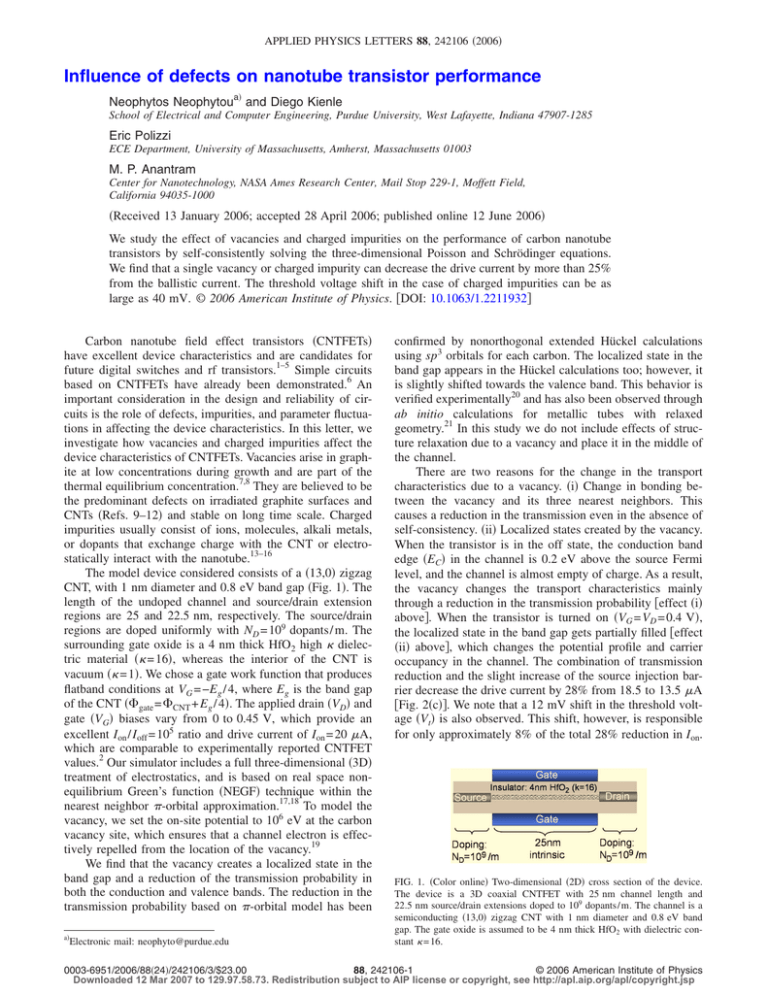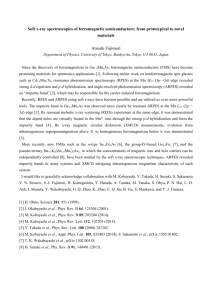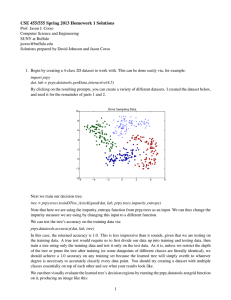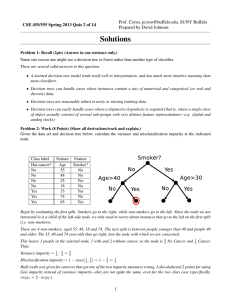Influence of defects on nanotube transistor performance Neophytos Neophytou and Diego Kienle
advertisement

APPLIED PHYSICS LETTERS 88, 242106 共2006兲 Influence of defects on nanotube transistor performance Neophytos Neophytoua兲 and Diego Kienle School of Electrical and Computer Engineering, Purdue University, West Lafayette, Indiana 47907-1285 Eric Polizzi ECE Department, University of Massachusetts, Amherst, Massachusetts 01003 M. P. Anantram Center for Nanotechnology, NASA Ames Research Center, Mail Stop 229-1, Moffett Field, California 94035-1000 共Received 13 January 2006; accepted 28 April 2006; published online 12 June 2006兲 We study the effect of vacancies and charged impurities on the performance of carbon nanotube transistors by self-consistently solving the three-dimensional Poisson and Schrödinger equations. We find that a single vacancy or charged impurity can decrease the drive current by more than 25% from the ballistic current. The threshold voltage shift in the case of charged impurities can be as large as 40 mV. © 2006 American Institute of Physics. 关DOI: 10.1063/1.2211932兴 Carbon nanotube field effect transistors 共CNTFETs兲 have excellent device characteristics and are candidates for future digital switches and rf transistors.1–5 Simple circuits based on CNTFETs have already been demonstrated.6 An important consideration in the design and reliability of circuits is the role of defects, impurities, and parameter fluctuations in affecting the device characteristics. In this letter, we investigate how vacancies and charged impurities affect the device characteristics of CNTFETs. Vacancies arise in graphite at low concentrations during growth and are part of the thermal equilibrium concentration.7,8 They are believed to be the predominant defects on irradiated graphite surfaces and CNTs 共Refs. 9–12兲 and stable on long time scale. Charged impurities usually consist of ions, molecules, alkali metals, or dopants that exchange charge with the CNT or electrostatically interact with the nanotube.13–16 The model device considered consists of a 共13,0兲 zigzag CNT, with 1 nm diameter and 0.8 eV band gap 共Fig. 1兲. The length of the undoped channel and source/drain extension regions are 25 and 22.5 nm, respectively. The source/drain regions are doped uniformly with ND = 109 dopants/ m. The surrounding gate oxide is a 4 nm thick HfO2 high dielectric material 共 = 16兲, whereas the interior of the CNT is vacuum 共 = 1兲. We chose a gate work function that produces flatband conditions at VG = −Eg / 4, where Eg is the band gap of the CNT 共⌽gate = ⌽CNT + Eg / 4兲. The applied drain 共VD兲 and gate 共VG兲 biases vary from 0 to 0.45 V, which provide an excellent Ion / Ioff = 105 ratio and drive current of Ion = 20 A, which are comparable to experimentally reported CNTFET values.2 Our simulator includes a full three-dimensional 共3D兲 treatment of electrostatics, and is based on real space nonequilibrium Green’s function 共NEGF兲 technique within the nearest neighbor -orbital approximation.17,18 To model the vacancy, we set the on-site potential to 106 eV at the carbon vacancy site, which ensures that a channel electron is effectively repelled from the location of the vacancy.19 We find that the vacancy creates a localized state in the band gap and a reduction of the transmission probability in both the conduction and valence bands. The reduction in the transmission probability based on -orbital model has been a兲 Electronic mail: neophyto@purdue.edu confirmed by nonorthogonal extended Hückel calculations using sp3 orbitals for each carbon. The localized state in the band gap appears in the Hückel calculations too; however, it is slightly shifted towards the valence band. This behavior is verified experimentally20 and has also been observed through ab initio calculations for metallic tubes with relaxed geometry.21 In this study we do not include effects of structure relaxation due to a vacancy and place it in the middle of the channel. There are two reasons for the change in the transport characteristics due to a vacancy. 共i兲 Change in bonding between the vacancy and its three nearest neighbors. This causes a reduction in the transmission even in the absence of self-consistency. 共ii兲 Localized states created by the vacancy. When the transistor is in the off state, the conduction band edge 共EC兲 in the channel is 0.2 eV above the source Fermi level, and the channel is almost empty of charge. As a result, the vacancy changes the transport characteristics mainly through a reduction in the transmission probability 关effect 共i兲 above兴. When the transistor is turned on 共VG = VD = 0.4 V兲, the localized state in the band gap gets partially filled 关effect 共ii兲 above兴, which changes the potential profile and carrier occupancy in the channel. The combination of transmission reduction and the slight increase of the source injection barrier decrease the drive current by 28% from 18.5 to 13.5 A 关Fig. 2共c兲兴. We note that a 12 mV shift in the threshold voltage 共Vt兲 is also observed. This shift, however, is responsible for only approximately 8% of the total 28% reduction in Ion. FIG. 1. 共Color online兲 Two-dimensional 共2D兲 cross section of the device. The device is a 3D coaxial CNTFET with 25 nm channel length and 22.5 nm source/drain extensions doped to 109 dopants/ m. The channel is a semiconducting 共13,0兲 zigzag CNT with 1 nm diameter and 0.8 eV band gap. The gate oxide is assumed to be 4 nm thick HfO2 with dielectric constant = 16. 0003-6951/2006/88共24兲/242106/3/$23.00 88, 242106-1 © 2006 American Institute of Physics Downloaded 12 Mar 2007 to 129.97.58.73. Redistribution subject to AIP license or copyright, see http://apl.aip.org/apl/copyright.jsp 242106-2 Neophytou et al. Appl. Phys. Lett. 88, 242106 共2006兲 FIG. 2. 共Color online兲 Effect of the vacancy on the electronic properties of the CNTFET. 共a兲 The conduction band of the control vs vacancy defected CNT at VG = 0.4 V and VD = 0.4 V. 共b兲 The carrier distribution along the channel of the two devices under bias conditions as in 共a兲. 共c兲 The ID-VG characteristics at VD = 0.4 V. Inset: the ID-VD for VG = 0.45, 0.35, and 0.25 V. FIG. 3. 共Color online兲 Effect of a negatively charged impurity in different locations of the device. The charged impurity is placed 共A兲 in the middle of the CNT, 共B兲 in the middle of the oxide, and 共C兲 near the gate electrode. 共a兲 The conduction band of the control vs the different charged impurity cases at VG = VD = 0.4 V. 共b兲 The carrier distribution along the channel for the impurity locations 共A兲–共C兲 and the same bias conditions as in 共a兲. 共c兲 The ID-VG characteristics for VD = 0.4 V. Inset: ID-VD for VG = 0.45 V. We also considered the case where the vacancy sits near the source and drain ends, and find that the drive current decreases by a similar amount, indicating that the decrease in drive current is independent of the vacancy location. We next investigate the effect of a negatively charged impurity having charge −兩q兩, where q is the charge of an electron. Three different locations of the impurity are considered: 共A兲 the interior of the CNT, 共B兲 the middle of the oxide, and 共C兲 the top of the oxide, 0.5 nm from the gate electrode 关inset of Fig. 3共b兲兴. We assume that the effect of the impurity on the device arises through electrostatic interactions, and ignore any minor structure deformations due to the impurity.16 We find that case 共A兲 gives rise to a large scattering center in the conduction band as shown in Fig. 3共a兲. Similar to the case of the localized state with a vacancy, electrons traveling from the source to the drain get reflected from this barrier and pileup/deplete to the left/right of the impurity 关Fig. 3共b兲兴. The comparison to the case of a vacancy is interesting. While the drive current is reduced by about 33%, similar to the case of the vacancy, there is now a large shift in the threshold voltage by about 40 mV. For an operating bias of 0.4 V, the threshold voltage shift is about 10%, a magnitude that can lead to large Ioff variations. In comparison to case 共A兲, the drive current and threshold voltage are affected very little in cases 共B兲 and 共C兲 共5% and 0.5% reductions, respectively兲. This behavior can be attributed to an effective screening of the impurity by the surrounding gate electrode, enhanced by the high dielectric of the gate insulator. Finally, we investigate the effect of a positively charged impurity placed at the same locations as in Fig. 3共b兲. While a negatively charged impurity in the center of the CNT creates a large barrier in the conduction band, a positive impurity creates a large potential well as shown in Fig. 4共a兲. The carrier density in the channel 关Fig. 4共b兲兴 slightly oscillates, and electrons are attracted around the positive impurity site in the middle of the channel. The top of the barrier, however, is not affected significantly in this case, and as a result the drive current deceases by only 11% as shown in Fig. 4共c兲. Quantum mechanical scattering from a potential well is weaker than scattering from a barrier. It is also interesting to see here that the shift in Vt is much smaller 共⌬Vt = −5 mV兲 and now negative. Finally, we find that cases 共B兲 and 共C兲, for which the impurity is placed in the oxide further away from the CNT shell, have an insignificant effect on the device performance. We would like to mention here that for a p-type device, the relative role of the positive and negative impurities would be reversed. In this letter, we examined the role of defects 共vacancies and charged impurities兲 in altering nanotube transistor characteristics from the ballistic limit. A single vacancy can cause drive current reduction by approximately 28%, independent of the location of the vacancy in the channel, for the device considered. While a single negatively charged impurity near the channel also decreases the drive current by a similar amount, it leads to a much larger threshold voltage shift, comparable to 40 mV 共10% of the power supply兲. The scattering strength of the charged impurity weakens as the scatterer is placed away from the CNT channel, close to the gate electrode. For an n-type device, a localized positively charged impurity causes a much smaller drive current degradation or Vt shift 共only 5 mV兲 compared to the negative impurity. It is quite remarkable that a single defect can cause such large degradation in drive current and threshold voltage Downloaded 12 Mar 2007 to 129.97.58.73. Redistribution subject to AIP license or copyright, see http://apl.aip.org/apl/copyright.jsp 242106-3 Appl. Phys. Lett. 88, 242106 共2006兲 Neophytou et al. DURINT, and by the NSF funded Network for Computational Nanotechnology. One of the authors 共M.P.A.兲 acknowledges NASA Contract No. NAS2-03144 to the University Affiliated Research Center, UC, Santa Cruz. The authors would like to thank M. S. Lundstrom for helpful discussions. 1 FIG. 4. 共Color online兲 Effect of a positively charged impurity in different locations of the device. The charged impurity is placed 共A兲 in the middle of the CNT, 共B兲 in the middle of the oxide, and 共C兲 near the gate electrode. 共a兲 The conduction band of the control vs the different charged impurity cases at VG = VD = 0.4 V. 共b兲 The charge distribution along the channel for the impurity locations 共A兲–共C兲 and the same bias conditions as in 共a兲. 共c兲 The ID-VG characteristics for VD = 0.4 V. Inset: ID-VD for VG = 0.45 V. shift. Design of circuits using these quasi-one-dimensional transistors should take this into consideration. This work was supported by the MARCO Focus Center on Materials, Structures, and Devices 共M. S. Lundstrom兲, P. L. McEuen, M. S. Fuhrer, and H. Park, IEEE Trans. Nanotechnol. 1, 78 共2002兲. 2 A. Javey, R. Tu, D. Farmer, J. Guo, R. Gordon, and H. Dai, Nano Lett. 5, 345 共2005兲. 3 J. Chen, C. Klinke, A. Afzali, and Ph. Avouris, Appl. Phys. Lett. 86, 123108 共2005兲. 4 Z. Yao, C. Kane, and C. Dekker, Phys. Rev. Lett. 84, 2941 共2000兲. 5 P. Burke, Proc. SPIE 5593, 52 共2003兲. 6 V. Derycke, R. Martel, J. Appenzeller, and Ph. Avouris, Nano Lett. 1, 453 共2001兲. 7 A. A. El-Barbary, R. H. Telling, C. P. Ewels, M. I. Heggie, and P. R. Briddon, Phys. Rev. B 68, 144107 共2003兲. 8 A. Hashimoto, K. Suenaga, A. Gloter, K. Urita, and S. Ijima, Nature 共London兲 430, 870 共2004兲. 9 Y. Fan, B. R. Goldsmith, and P. G. Collins, Nat. Mater. 4, 906 共2005兲. 10 A. V. Krasheninnikov, K. Nordlund, M. Sirvio, E. Salonen, and J. Keinonen, Phys. Rev. B 63, 245405 共2001兲. 11 A. V. Krasheninnikov, K. Nordlund, and J. Keinonen, Phys. Rev. B 65, 165423 共2002兲. 12 C. Gomez-Navarro, P. J. De Pablo, J. Gomez-Herrero, B. Biel, F. J. Garcia-Vidal, A. Rubio, and F. Flores, Nat. Mater. 4, 534 共2005兲. 13 J. Lu, S. Nagase, S. Zhang, and L. Peng, Phys. Rev. B 69, 205304 共2004兲. 14 M. Radosavljevic, J. Appenzeller, and Ph. Avouris, Appl. Phys. Lett. 84, 3693 共2004兲. 15 T. Takenobu, T. Takano, M. Shiraishi, Y. Murakami, M. Ata, H. Kataura, Y. Achiba, and Y. Iwasa, Nature 共London兲 2, 683 共2003兲. 16 C. Jo, C. Kim, and Y. H. Lee, Phys. Rev. B 65, 035420 共2002兲. 17 E. Polizzi and B. N. Abdallah, Phys. Rev. B 66, 245301 共2002兲. 18 J. Guo, S. Datta, M. Lundstrom, and M. P. Anantram, Int. J. Multiscale Comp. Eng. 2, 257 共2004兲. 19 M. P. Anantram and T. R. Govindan, Phys. Rev. B 58, 4882 共1998兲. 20 S. Lee, G. Kim, H. Kim, B.-Y. Choi, J. Lee, B. W. Jeong, J. Ihm, W. Kuk, and S.-J. Kahng, Phys. Rev. Lett. 95, 166402 共2005兲. 21 H. J. Choi, J. Ihm, S. G. Louie, and M. L. Cohen, Phys. Rev. Lett. 84, 2917 共2005兲. Downloaded 12 Mar 2007 to 129.97.58.73. Redistribution subject to AIP license or copyright, see http://apl.aip.org/apl/copyright.jsp





